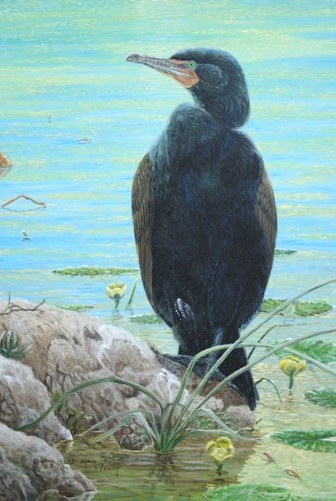
Two double-crested cormorants on an island of seagulls in Lake Nipissing, Ontario. Image: Flickr, Liam Quinn
By Kayla Smith
Canadian researchers are plunging deep beneath the ammonia-rich bird crap of eastern Lake Ontario’s islands to uncover the ecological implications of a growing population of double-crested cormorants.
Their report, “Tracking the History and Ecological Changes of Rising Double-Crested Cormorant Populations Using Pond sediments from Islands in Eastern Lake Ontario,”was published recently by the Public Library of Science.
It says the birds “are clearly having a major impact on the present ecology of the island’s ponds.”
The organic waste at the nesting sites raise nutrients in the soil and water. That makes algae bloom in ponds but decimates the islands of vegetation.
The toxic ammonia in cormorant guano threatens the Carolinian forests in eastern Ontario, the study says.
The guano’s presence is obvious by the pea green sand covering all of the eastern Ontario islands that house flocks of seabirds from April to November, said John Smol, a professor in the department of biology at Queen’s University in Kingston, Ontario, and co-author of the report.
The islands are noticeably bare, except for a few hardy shrubs and vines that can survive the high phosphorus and nitrogen levels in the bird waste.

Original portrait of a double-crested cormorant. Image: Barry K. MacKay
Killing the birds, once on the brink of extinction, is controversial. By the 1970s, they were nearly killed off by a combination of organochloride pesticides, like DDT, and eradication methods led by commercial fishing outfits.
Advocates for the Great Lakes rallied around the birds as symbols of how water contamination hurts wildlife.
Since the regulation of such pesticides, the birds have experienced exponential population growth. They grew from 136 breeding pairs in the 1970s to more than 100,000 breeding pairs in the 2000s, according to the report published under Queen University’s Paleoecological Environmental Assessment and Research Lab.
Cormorant nesting grounds threaten a rare ecosystem on Middle Island in Lake Erie that is comprised of 150 plant and animal species, including nine that are at risk species, according to Parks Canada, a federal agency responsible for protecting rare species in national parks and other protected areas.
In hopes of restoring the ecosystem, Parks Canada launched a five-year program to kill the birds in 2008. But the decision has opponents.
“Cormorants are scapegoated for our activities,” said Barry Kent MacKay, a member of Cormorant Defenders International and a senior program associate of Born Free USA.
“The islands are not, or in my opinion should not be, maintained as essentially gardens, all manicured with the ‘undesirables’ weeded out,” MacKay said. “The cormorants belong there if anything does, and possibly more than, say, Kentucky coffee trees.”
MacKay and other supporters argue that the increasing population of the birds may be a natural ecological process.
Smol and his fellow researchers worked to uncover the ecological niche of the cormorant to see if there is any supporting evidence.
“From a management perspective, it is critical to know the history of the bird populations,” Smol said. “Have they ever been this high in numbers before? When did they arrive?”
The researchers used a paleoecological approach to track the history of the birds and their effects on ponds. Paleoecology is the interaction between ancient organisms and their environment.
The researchers retrieved core samples of pond sediment, dated them and gathered information from the types of algae in each layer of dirt. What they found were high traces of Fistulifera saprophila, an algae extremely tolerant of highly polluted waters.
By studying the population increases of the algae over time and comparing it to current algae populations at cormorant nesting sites, they found a relationship between nesting sea-bird colonies and water contamination.

Original portrait of a double-crested cormorant. Image: Barry K. MacKay
Smol and his researchers believe their preliminary study provides scientists with new approaches for pulling data from ancient algae that can be useful for studying lake and river management, tracking environmental change and making environmental assessments.
“I think we show ‘proof of concept’ and that these approaches can be applied more broadly,” he said.
The double-crested cormorant can now be placed into ecological and socioeconomic context by analyzing bacteria that thrive in ancient bird waste, the report concluded.